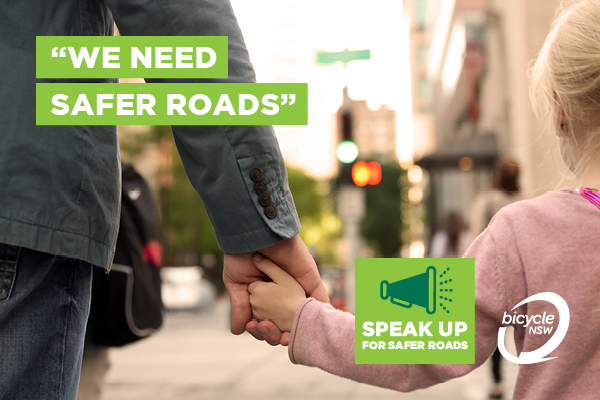It’s time to speak up in order to make our road environment safer! The 2026 Road Safety Action Plan is currently open for feedback and we need you to share how the road environment can be improved to make it safer for you.
We really need your feedback to ensure our roads do not remain unsafe for the next 5 years.
Copy and Paste Into The Survey
Below we have outlined some important road safety issues along with some paragraphs you can copy and paste when filling out the survey.
Safer Vehicles
Recently, focus for safer roads has been on motor vehicles and the safety of the passengers inside them. This has failed to address the hazards posed to bike riders and pedestrians by bigger vehicles, bull-bars, blind spots, heavy vehicles without safety measures such as side underrun protection or blind spot detection.
I would like to see regulation and heavy vehicle safety technologies including:
- Side (to protect pedestrians and cyclists from going under heavy vehicles) and rear (to reduce the intrusion into a car’s passenger compartment) underrun protection systems
- Autonomous Emergency Braking
- Fatigue Monitoring systems
- Lane Departure Warning systems
- Enhanced vehicle visibility markings
- Enhanced driver’s field of view through the introduction of blind spot information system
- Anti-lock braking/Electronic braking systems
- Electronic Stability and anti-rollover
- Cabin rollover protection
Safer Roads
Until COVID-19, safe roads appeared to almost exclusively focus on the safety of motor vehicle operators and occupants. It missed the point of making the roads safer for the most vulnerable road users including pedestrians, bike riders, scooters, wheelchairs users etc.
There are rapid, low-cost changes that can be made to road infrastructure within 1-2 years to make cycling safer including:
- Reducing speed limits
- Using audio-tactile line markings and double lines on motorways to deter egress from road lanes into cycling lanes or the road shoulder, as well as to alert fatigued drivers
- Altering the placement of parking so that painted bike lanes are protected by parked cars, rather than bicycle riders being allocated the door zone and protecting parked motor vehicles
- Replacing pedestrian lanterns with dual bike and pedestrian lanterns to enable safe, legal road crossing
Increasing Road Safer For Bike Riders
Reducing speeding, distracted driving and driver intoxication are all important, but the most dangerous road feature for bike riders according to the crash data is intersections. The new plan contains no enforcement strategy or infrastructure changes to address this. Unsafe passing continues to be a major issue for riders, but enforcement and driver education remains poor.
To reduce bike rider injuries and fatalities we need:
- Better enforcement of safe passing laws,
- More safe separated infrastructure for riders,
- Redesigned intersections and road features to improve bike rider safety,
- Driver education to improve knowledge of, and adherence to, the laws that keep riders safe and
- Changes in the laws and road design to improve rider safety.
Safe Speeds
Safe speeds are an excellent idea and reducing the speed motor vehicles travel at can make a big difference to the outcome of road crashes.
Statistics show at 50km/h, the average speed of suburban streets in Australia, the risk of a pedestrian or cyclist dying in an accident with a motor vehicle is 55%, this drops to 25% at 40km/h and 5-10% at 30km/h.
We would like to see safe speeds introduced by using traffic calming, speed signs and enforcement to reduce travel speeds in suburbs and local neighbourhoods to 30 km/hr.
Safer Roads Users
Our most vulnerable road users are at risk and not enough is being done to make them safer.
Education, licensing systems and enforcement all have a place in making people safer on the road, but opportunities are being missed.
Education and licensing - There has been a failure to educate new drivers and those renewing licenses. Along with missed opportunities to educate on social media when those expressing aggression towards bike riders and pedestrians are self-identifying their need for education and behaviour change.
Enforcement - The current focus of policing and road safety data in NSW is on alcohol, speed and fatigue and more recently mobile phone use. However, law breaking, negligent and deliberately aggressive driving are a common bike rider experience, cause of crashes which are rarely acted on.
Bicycle NSW would like to see high impact road safety education campaigns to promote safe driving around bicycle riders, and that ongoing measurement be undertaken to determine the impact, and adjust messages to improve road safety culture and attitudes towards bike riders.
Following Policy
Great policies have already been developed to ensure our roads are a safe environment, except most of the time these are not followed, making for a dangerous place for road users.
We would like to see the Government and it’s contractors follow their own laws and policies on roads including RMS 2013 supplements to the Australian Standards, Providing for Walking and Cycling in Transport Projects Policy, Road User Space Allocation Policy, as well as utilising the AustRoad guidelines for safer roads.
You can see the full Bicycle NSW submission here.

